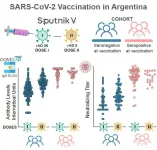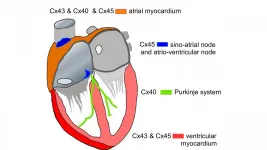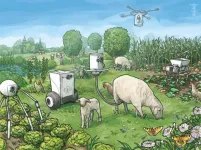Less is more: the efficient brain structural and dynamic organization
2021-07-13
(Press-News.org) The human brain has extreme ability in thinking and computation, but it only requires a very low energy power of about 20W, which is much lower than that of electronic computers. The neuronal connections in the brain network have a globally sparse but locally compact modular topological characteristics, which greatly reduces the total resource consumption for establishing the connections. The spikes of each neuron in the brain are sparse and irregular, and the clustered firing of the neuronal populations has a certain degree of synchronization, forming neural avalanches with scale-free characteristics, and the network can sensitively respond to external stimuli. However, it is still not clear how the brain structure and dynamic properties can self-organize to achieve their co-optimization in cost efficiency. Recently, Junhao Liang and Changsong Zhou from Hong Kong Baptist University and Sheng-Jun Wang from Shaanxi Normal University, tried to address this issue by a biological neural network model through large-scale numerical simulation, combined with a novel mean-field theory analysis. In their research article published in the National Science Review (NSR), they studied the excitation-inhibition balance neural dynamics model on the spatial network.
The research showed that: when a globally sparse randomly connected network (RN) is rewired to a more biologically realistic modular network (MN), the network's running consumption (neuron firing rate) and its building cost of connection are both significantly reduced; the dynamic mode of the network transitions to the region allowing scale-free avalanches (that is, criticality), which makes the network more sensitive in responding to external stimuli (see Figure 1).
Further analysis found that the increased connection density of single modules during the rewiring process is key to account for the dynamical transitions: higher network topological correlation leads to higher dynamical correlation, which makes neurons to firing spikes more easily. Using a novel approximate mean-field theory, the authors derived the macroscopic field equations of a single module, revealing that the increase of module density causes the decrease of neural firing rate and the proximity to the Hopf bifurcation of the system. This explains the formation of critical avalanches and the increased sensitivity to external stimuli with lower firing cost. The coupled oscillator model obtained by coupling multiple modules further reveals the dynamic transition during the rewiring process of the original network (see Figure 2).
The research clearly showed a principle of achieving a co-optimization of (rather than a trade-off between) the brain structural and dynamic properties, and offers a novel understanding of the cost-efficient operational principle of the brain, which also provides insights to the design of brain-inspired computational devices.
INFORMATION:
See the article:
Junhao Liang, Sheng-Jun Wang and Changsong Zhou
Less is more: Wiring-economical modular networks support self-sustained
firing-economical neural avalanches for efficient processing
National Science Review, nwab102, https://doi.org/10.1093/nsr/nwab102
[Attachments] See images for this press release:

ELSE PRESS RELEASES FROM THIS DATE:
2021-07-13
While attending a conference at the Universidad Nacional Autónoma de México in Mexico City several years ago, Sharon Borja was struck by the story of a young man who, as a child, joined his parents repatriating to their native country of Mexico. Like millions of Mexican immigrants, the family had called the United States home for years, and having been born in the U.S., he was an American citizen. Walking one day in his newfound urban Mexican neighborhood, a couple carrying a wooden stick approached him on the street and encouraged him to ...
2021-07-13
A new study from researchers at the University of Liverpool shows that decreasing local government funding over recent years probably contributed to declines in life expectancy in some areas of England, which was stalling even prior to the COVID-19 pandemic.
Local government funding and life expectancy in England, a longitudinal ecological study published in The Lancet Public Health, linked annual local government funding data from the Ministry of Housing, Communities, and Local Government with life expectancy and mortality data from Public Health England between 2013 and 2017.
Corresponding author Dr Alexandros ...
2021-07-13
A USC analysis of deaths among individuals in U.S. Immigration and Customs Enforcement custody found that ICE violated its own internal medical care standards in 78% of cases, potentially contributing to deaths in relatively young and healthy men.
The study appears in END ...
2021-07-13
New research from the University of Georgia finds that older Mexican Americans who live in low English-speaking neighborhoods are at greater risk for poor health and even an early death.
Language barriers can be a significant deterrent to health. People who don't speak English well are less likely to seek health care or receive health information. This can lead to delay of care and missed health screenings for chronic disease and cancers. Language isolation is also linked to poor mental health.
These issues only compound as non-English speakers age, said study co-author Kerstin Emerson, a clinical ...
2021-07-13
A single dose of the Sputnik V vaccine may elicit significant antibody responses against SARS-CoV-2, finds a study published July 13 in the journal Cell Reports Medicine.
"Due to limited vaccine supply and uneven vaccine distribution in many regions of the world, health authorities urgently need data on the immune response to vaccines to optimize vaccination strategies," says senior author Andrea Gamarnik (@GamarnikLab) of the Fundación Instituto Leloir-CONICET in Buenos Aires, Argentina. "The peer-reviewed data we present provide information for guiding public health decisions in light of the current global health emergency."
Past research has shown that two doses of Sputnik V results in 92% efficacy against ...
2021-07-13
Feeling extra sweaty from a summer heat wave? Don't worry--not all your perspiration has to go to waste. In a paper publishing July 13 in the journal Joule, researchers have developed a new device that harvests energy from the sweat on--of all places--your fingertips. To date, the device is the most efficient on-body energy harvester ever invented, producing 300 millijoules (mJ) of energy per square centimeter without any mechanical energy input during a 10-hour sleep and an additional 30 mJ of energy with a single press of a finger. The authors say the device represents a significant ...
2021-07-13
WASHINGTON, July 13, 2021 -- The rhythm in a working heart is regulated by electrical impulses. Disturbances of this bioelectrical process can result in cardiac arrhythmias, or irregularities in heartbeat -- a common ailment that can lead to illness and death.
In Biophysics Reviews, by AIP Publishing, researchers from Harvard Medical School provide a state-of-the-art update on how electrical impulses in the heart travel from cell to cell.
A functioning heart contracts to pump blood to the body and the lungs. Within the heart, a pacemaker acts as an electrical clock, sending out a signal that tells the heart when to contract. The whole muscle moves together, because ...
2021-07-13
No longer science fiction, farm robots are already here--and they have created two possible extremes for the future of agriculture and its impacts on the environment, argues agricultural economist Thomas Daum in a Science & Society article published July 13 in the journal Trends in Ecology & Evolution. One is a utopia, where fleets of small, intelligent robots farm in harmony with nature to produce diverse, organic crops. The other is a dystopia in which large, tractor-like robots subdue the landscape through heavy machinery and artificial chemicals.
He describes the utopian scenario as a mosaic ...
2021-07-13
PITTSBURGH, July 13, 2021 - Substantially more people in the U.S. with opioid use disorder are receiving evidence-based treatment for the disease, but there are still considerable gaps in care along racial lines, according to the largest analysis to date of opioid use disorder among Medicaid recipients.
The results, published today in JAMA, provide insights that policymakers and medical providers can act on to improve access to quality care for opioid use disorder, one of the leading causes of death in the U.S. The analysis was possible because of a unique network that partnered academic institutes with state Medicaid programs to overcome barriers to data sharing between states.
"Medicaid plays an incredibly important role in our ...
2021-07-13
A new wearable device turns the touch of a finger into a source of power for small electronics and sensors. Engineers at the University of California San Diego developed a thin, flexible strip that can be worn on a fingertip and generate small amounts of electricity when a person's finger sweats or presses on it.
What's special about this sweat-fueled device is that it generates power even while the wearer is asleep or sitting still. This is potentially a big deal for the field of wearables because researchers have now figured out how to harness the energy that can be extracted from human sweat even when a person is not moving.
This type of device is ...
LAST 30 PRESS RELEASES:
[Press-News.org] Less is more: the efficient brain structural and dynamic organization





